Another kind of bridge
Friday, September 26th, 2008Does anyone out there have a picture of the Clintonville Bridge Club, which met in the basement of the Olentangy Village Tavern for perhaps 50 years until the 1970s/1980s?
Does anyone out there have a picture of the Clintonville Bridge Club, which met in the basement of the Olentangy Village Tavern for perhaps 50 years until the 1970s/1980s?
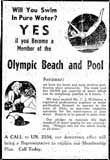 I love this ad for Olympic Beach in 1939. “Of interest to the ‘bathers’ of Northern Columbus is the care and precaution the management of the Olympic Pool is taking so that our families may swim in perfectly safe water, free from impurities and its dangers…“ Shortly after the pool was built, the Olympic Amusement Corporation, headed by Orr Zimmerman, assumed ownership of the pool. For many years the O.S.U. swimming and diving teams practiced there and many contestants for the summer Olympics came from all over the United States to train at the pool. Several national championships have been held there. Early on, only male lifeguards worked at the pool.
I love this ad for Olympic Beach in 1939. “Of interest to the ‘bathers’ of Northern Columbus is the care and precaution the management of the Olympic Pool is taking so that our families may swim in perfectly safe water, free from impurities and its dangers…“ Shortly after the pool was built, the Olympic Amusement Corporation, headed by Orr Zimmerman, assumed ownership of the pool. For many years the O.S.U. swimming and diving teams practiced there and many contestants for the summer Olympics came from all over the United States to train at the pool. Several national championships have been held there. Early on, only male lifeguards worked at the pool.
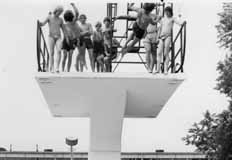 Here, someone does a kamikaze dive off the tallest tower. (Photos courtesy of the Zimmerman family)
Here, someone does a kamikaze dive off the tallest tower. (Photos courtesy of the Zimmerman family)
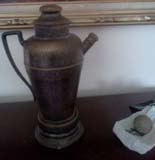 As the author of a book on the History of Clintonville, I often get fun calls from people who own a tiny bit of Clintonville history and want a bit more. This morning was one of those days. Ian Crowe called me from Utah. He’d purchased a trophy at a local estate sale, and was wondering where the trophy was from and who won it.
As the author of a book on the History of Clintonville, I often get fun calls from people who own a tiny bit of Clintonville history and want a bit more. This morning was one of those days. Ian Crowe called me from Utah. He’d purchased a trophy at a local estate sale, and was wondering where the trophy was from and who won it.
The trophy was for an Indian Springs Golf Club, in 1931. Could it be Clintonville’s own Indian Springs Golf Club?
Apparently Ian had called quite a few golf clubs by the same name, until he found my web site.
I referred the question to Scott Caputo at the Columbus Metropolitan Library. His research can be found here. He learned that the golf course did exist in 1931–Indian Springs Golf Club was listed in the telephone directory as early as 1929, and had been issued a building permit for a new clubhouse in 1931. He learned that there was a Norman I. Blanchard living on 385 Wyandotte, just 3-1/2 miles from the course. According to census records, Norman would have been about 23 or 24 at the time of the tournament.
So, the trophy is extremely likely to have come from the Clintonville golf course.
When I exclaimed that the trophy was really a martini shaker, I was informed that this was a very common form of golf trophy back then.
Great job, Scott!
 In a previous post, I mentioned getting a call about a golf trophy for Indian Springs Golf Club.
In a previous post, I mentioned getting a call about a golf trophy for Indian Springs Golf Club.
That same day, I happened upon this history of Indian Springs Golf Course, from The Booster, Friday, December 1,
1939, page 9-B.
In a nutshell:
–The land was originally part of the Dyer estate;
–Golf Course was laid out with 152 acres in 1926;
–Ground was leased by Herb Bash (who, I should add, later opened a driving range called Bash Golf on Dodridge–which he later sold to Chem Abstracts–and then opened a driving range in Dublin on Riverside Road);
–In 1938 the golf club became Overbrook Country Club;
–The first clubhouse was on North High at Cooke Road
–By 1939 the club was open year-round, catering to parties and dances.
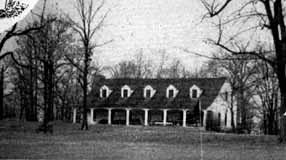 The 46-acre Indian Springs Golf Course extended east of High Street to Indianola, north of East Cooke Rd and south of Schreyer. It opened as a 18-hole course in 1931 and closed circa 1947 as a 9-hole course. The Indian Springs Village subdivision was built in this location around 1947. (Photo courtesy of Columbus Metropolitan Libraries)
The 46-acre Indian Springs Golf Course extended east of High Street to Indianola, north of East Cooke Rd and south of Schreyer. It opened as a 18-hole course in 1931 and closed circa 1947 as a 9-hole course. The Indian Springs Village subdivision was built in this location around 1947. (Photo courtesy of Columbus Metropolitan Libraries)
Robert Ohaver (b. 1920) lived most of his life in Clintonville and on West North Broadway. He had many stories of old Clintonville to share with us. On September 12, 2003, several community members (Ann and Alan Woods, Barbara Hotchkiss, Nancy Kuhel) interviewed him and preserved the conversation on tape. Now you, too, can listen to Mr. Ohaver’s oral history.
Sadly, Bob Ohaver passed away on June 11, 2009. You can find his obituary here. There is another small entry about his aunt on this web site here.
Bob mother was Laura Ohaver and his father was Walter Harvey Ohaver. Bob also had an older brother named Jack Ohaver who lived in Clintonville at 116 E. Dunedin with his wife Clara Ohaver. Clara passed away May 24, 1993, and Jack passed away on June 14, 2000. Jack and Clara had two daughters. Sue Bowman was born May 8, 1940; she passed away January 4, 2000. Sandra Urban born July 30, 1945. [This family information came to me from Jack’s granddaughter and Sandy’s daughter, Lisa Adkins. Thanks, Lisa!]
Each file is about 30 minutes long.
Contents
Track 1.
Brief Ohaver biography; origins of his family moving to West North Broadway; his World War II years; Clinton Theatre; businesses and homes at the interesection of North Broadway and North High Streets; drugstores and candy stores in Clintonville; the house behind 3391 North High Street; Dispatch carrier’s substation; Olentangy Park; the streetcar storage barn at Arcadia.
Track 2.
Olentangy Park cont’d; street fair at North Broadway and High to celebrate Clinton Theatre, the opening of Clinton School pedestrain subway, and the paving of North High Street after a new sewer line had been installed; the Olentangy River; 3 canoe clubs; development of West North Broadway (“the Broadway Extension”) and the Scott farm; development of the area along the adjoining river bank; the Herron [spelling uncertain]/Zinn home at 285 West Kenworth; Bill Moose AKA “Indian Bill”; Chief Leatherlips.
Note: the “Dr. John Scott” is William H. Scott, president of OSU 1883-1895. See my book, page 17, for a photo of his house.
Track 3.
Chief Leatherlips cont’d; house at 273 Erie Road and excavation of nearby gravel pit; the Fuller farm/Whetstone Park; rambling through the woods; Indian Springs golf course; Bill Moose AKA “Indian Bill”; Olentangy Park; North Columbus including the Ramlow Building; Picadilly Theatre; streetcars and interurbans.
Track 4.
Southwick funeral home; Joy Hunt home; Graceland Shopper’s Mart and Patrick Murnan; Clinton Theatre; the Great Depression; Ohaver family; Brighton Road development; Ohaver’s WWII and postwar years.
Track 5.
Ohaver’s return to Columbus from California in 1962; bombing of the Clinton Theatre in the 1930s.
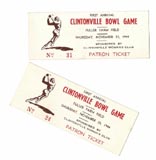 My book contains a photograph of the annual Turkey Bowl, a football game held in a local park on Thanksgiving day. Attached is a picture of some actual tickets to the event, for 1944! Betty Daniels gave these to the Clintonville Historical Society. [Photo courtesy of the Clintonville Historical Society]
My book contains a photograph of the annual Turkey Bowl, a football game held in a local park on Thanksgiving day. Attached is a picture of some actual tickets to the event, for 1944! Betty Daniels gave these to the Clintonville Historical Society. [Photo courtesy of the Clintonville Historical Society]
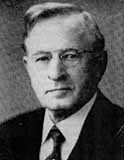 One of Clintonville’s notables was George Sidney Marshall (869-1956). He was raised on a farm in Perry County and attended Ohio State University. He graduated from OSU in 1894 and then from its law school in 1897. He was active in local politics, and became mayor in 1910 on the Republican ticket. After his term of mayor, he returned to the practice of Law and retired in 1946. He and his wife had a longstanding interest in music, and formed the Clintonville Music Study Club. In his retirement (and after the death of his wife), Marshall wrote a history of music in Columbus, a thorough account of all the local nonprofit musical organizations across the city. His book, called The History of Music in Columbus, Ohio, covers the period from February 14, 1812 to July 1, 1953 and was published by the Franklin County Genealogical Society.
One of Clintonville’s notables was George Sidney Marshall (869-1956). He was raised on a farm in Perry County and attended Ohio State University. He graduated from OSU in 1894 and then from its law school in 1897. He was active in local politics, and became mayor in 1910 on the Republican ticket. After his term of mayor, he returned to the practice of Law and retired in 1946. He and his wife had a longstanding interest in music, and formed the Clintonville Music Study Club. In his retirement (and after the death of his wife), Marshall wrote a history of music in Columbus, a thorough account of all the local nonprofit musical organizations across the city. His book, called The History of Music in Columbus, Ohio, covers the period from February 14, 1812 to July 1, 1953 and was published by the Franklin County Genealogical Society.
George Sidney Marshall’s son, George B. Marshall, was also an attorney and served as a Franklin County Common Pleas Court Judge for 26 years. He retired in 1980 and died in 1981.
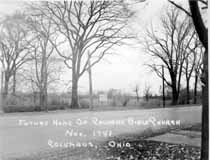 E.A. Fuller was a prominent Clinton Township horse trader at the turn of the century. I found the Clinton Township records for the late 1800s and early 1900s, and his name was frequently mentioned as buying or selling horses. I assume that the so-called “Fuller Farm”—where Calvary Bible Church, Whetstone Park, Clintonville Women’s Club, and The Church of Christ, Scientist are today—once belonged to this man. (Photo courtesy of Calvary Bible Church)
E.A. Fuller was a prominent Clinton Township horse trader at the turn of the century. I found the Clinton Township records for the late 1800s and early 1900s, and his name was frequently mentioned as buying or selling horses. I assume that the so-called “Fuller Farm”—where Calvary Bible Church, Whetstone Park, Clintonville Women’s Club, and The Church of Christ, Scientist are today—once belonged to this man. (Photo courtesy of Calvary Bible Church)
The vacant farm has been put to many uses. During World War II, the land used for victory gardens. (There were also victory gardens near Riverside Hospital.) Children put the area to their own purposes, scrambling through the undergrowth and playing by the river. 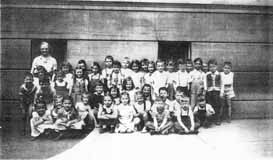 Many long-time residents recall a family that lived in the farm house—some have called it a log cabin, others say it was a chicken coop–of the old Fuller Farm. Some say the family was partly Native American; others say partly Romani; in any case, the family’s race added to their mystique and exoticism in the minds of the Clintonville children of the time. The family’s surname was Windsor; Mr. Windsor was a professor at OSU, and many of the people fondly recall daughter Zolithia [or Zelitha] (back row, 4th from left) and her brother Romanus (3rd rw, 2nd from right).
Many long-time residents recall a family that lived in the farm house—some have called it a log cabin, others say it was a chicken coop–of the old Fuller Farm. Some say the family was partly Native American; others say partly Romani; in any case, the family’s race added to their mystique and exoticism in the minds of the Clintonville children of the time. The family’s surname was Windsor; Mr. Windsor was a professor at OSU, and many of the people fondly recall daughter Zolithia [or Zelitha] (back row, 4th from left) and her brother Romanus (3rd rw, 2nd from right).
During or shortly after World War II, Rand Hollenback (founder of The Booster) lobbied for remaining land to be converted into a park, and the City of Columbus purchased the 161 acre farm. It became Whetstone Park. From early on the park has included a casting pond, softball diamond, tennis, picnic and playground, and archery field.
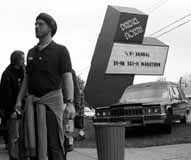 Mark Fontana is a former manager of the Beechwold Drexel North Theater, and he has started a Facebook page devoted to preserving the history of this theater. Also known as Beechwold Theater or Camelot North, it was located at 4250 North High Street and the building currently hosts the Columbus Sports Connection. When the building was a theater, it also served as temporary worship space for several churches in the area while the churches were being enlarged or rebuilt. Check out Mark’s web site!
Mark Fontana is a former manager of the Beechwold Drexel North Theater, and he has started a Facebook page devoted to preserving the history of this theater. Also known as Beechwold Theater or Camelot North, it was located at 4250 North High Street and the building currently hosts the Columbus Sports Connection. When the building was a theater, it also served as temporary worship space for several churches in the area while the churches were being enlarged or rebuilt. Check out Mark’s web site!